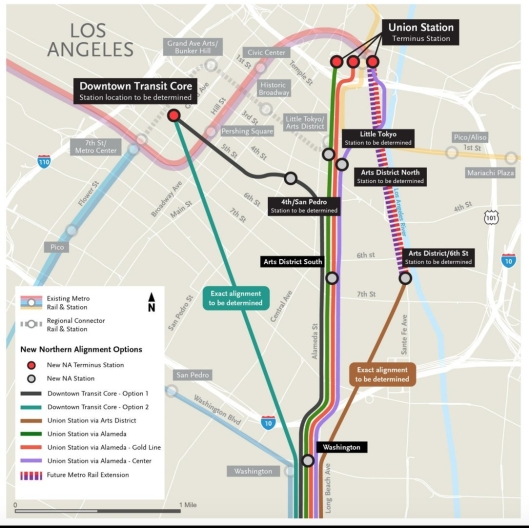In the past several months anguished articles have been popping up about the Arts District subway extension, a project that seemed in danger of stalling after Metro CEO Phil Washington commented that it would take divine intervention to get a station at 6th and Santa Fe built. Far from what you would expect for a project on the outs, in this month’s Metro board meetings, the project is suddenly everywhere.
It makes a bold-faced appearance in the map of new Artesia Line alternatives, as though its construction were in no doubt at all.

It is also being being added to the unconstrained project list for SCAG’s Regional Transportation Plan at the request of the city of Los Angeles. And, there it is again, appearing as the centerpiece of a grant application from the city to Metro to complete necessary studies for the establishment of an Enhanced Infrastructure Finance District in the downtown area.
The district defined by the City would cover the vast majority of downtown LA and is envisioned as the primary funding vehicle for a suite of transit spending including the extension of the heavy rail subway from Union Station as well as “capital improvements to the Blue / Expo Line throughout the Flower St and Washington Blvd corridors,” active transportation projects, increased bus service in southeast downtown neighborhoods, and the expansion of a 7th Street pedestrian corridor all the way to the L.A. river.
Part of the feasibility study would involve gauging the revenue that could be raised over the life of the EIFD, but the tentative project list is ambitious. Based on prior Metro documents, the projects listed will likely come in somewhere over $1 billion if they involve undergrounding the Blue and Expo Lines on Flower and Washington.
EIFDs are relatively new instruments established by the state legislature in 2014 following Governor Brown’s decision to wind down the redevelopment agencies. The districts can be used to create Joint Powers Authorities with the power, like the old CRA, to collect and spend marginal tax growth resulting from increases in assessed property value. This makes the EIFD an ideal financing mechanism in locations where real estate development is intensifying.
Under the legislation, the creation of an EIFD is limited to cities, counties, and special districts, which excludes Metro. But as a means of incentivizing cities to consider upzoning parcels near transit, Metro is offering grants to cities that want to study setting up EIFDs.
Another EIFD has been proposed for parcels within one mile of the Los Angeles River that could use 75% of the tax increment belonging to the City and County of Los Angeles to fund a series of unfunded river revitalization projects, and which would overlap the new prospective EIFD in the Arts District.
This type of city-driven Metro expansion would be precedent-setting in Los Angeles. The City also indicates its intention to go further, saying it will “explore using various transportation funds (Measure R & M local return, etc) to leverage the EIFD funds in order to implement projects on a faster time line.” This is a strategy I advocated Los Angeles to take elsewhere, using some of the $250 million annually that they get from transportation tax local return to accelerate projects within their jurisdiction.
So it seems, at least in a limited way, that Los Angeles is ready to take the reins. But even while Metro has cast doubt on the project, they have nonetheless been facilitating the arrival of rail in the Arts District. The previous round of studies, completed early last year, found incongruities between the plans to redesign the railyard to accommodate the Purple Line Extension and the work necessary to build a 6th Street station. Metro has since changed that project in order to facilitate the construction of the station near 6th and Santa Fe.
The Blue and Expo Line improvements are included in the Mayor’s 28×28 initiative to complete transit infrastructure before the Olympic Games return to the City in 2028, and have no dedicated funding elsewhere. According to the timeline laid out by staff in the application, the City plans to kick off the study in early 2019 and environmental work for the district and associated projects would be targeted for completion by December 2021.

I think tax increment financing would be a great way to fund the Red/Purple east side extensions in much the same way the NoMa Red line station was funded in DC. A 6th and Santa Fe station would bring benefit primarily to property owners and residents near 6th and Santa Fe, so asking them to pitch in some funding for it in exchange for upzoning makes sense.
The Blue/Expo WYE is different though. There isnt much upzoning to be zone and the benefits of the WYE are not really apparent to property owners near the junction but rather spread across the whole city. It will also be much more costly.
LikeLike
You don’t need to upzone. You just need land use intensification, which is happening, and will continue to happen around the wye and in the Figueroa corridor in general. I agree about the benefits of undergrounding the wye extending beyond L.A. city limits, but nonetheless Los Angeles has the clearest motivation to act quickly on this. Metro should absolutely help fund, but if the city’s actions mean this can get done in a decade instead of 30 years, I’m for it.
LikeLike